Disneyland – Anaheim, California
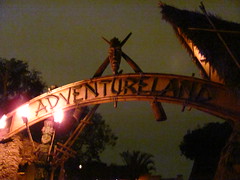 The spirit of adventure awaits beyond the entry gate illuminated by the flickering of tiki torches, beckoning explorers into the heart of the uncharted jungles of Africa and Southeast Asia. I sometimes consider Adventureland my favorite of the Disney lands to simply walk around and explore. The pathways are narrower and more intimate, the dense forestation simultaneously provides shade while keeping the field of view nearby, and overall the land is the richest in visual texture of any of Disney’s themed environments. Yet despite the abundance of real trees and natural building elements, the area also seems nearly as cartoonish as Fantasyland, presented as an amalgamation of popular fiction drawing equal inspiration from the African Queen and Around the World in 80 Days. The 1930’s throwback setting in a colonial British outpost,
The spirit of adventure awaits beyond the entry gate illuminated by the flickering of tiki torches, beckoning explorers into the heart of the uncharted jungles of Africa and Southeast Asia. I sometimes consider Adventureland my favorite of the Disney lands to simply walk around and explore. The pathways are narrower and more intimate, the dense forestation simultaneously provides shade while keeping the field of view nearby, and overall the land is the richest in visual texture of any of Disney’s themed environments. Yet despite the abundance of real trees and natural building elements, the area also seems nearly as cartoonish as Fantasyland, presented as an amalgamation of popular fiction drawing equal inspiration from the African Queen and Around the World in 80 Days. The 1930’s throwback setting in a colonial British outpost,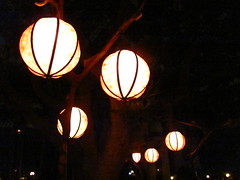 with often comical and sometimes politically questionable props and set pieces, makes Adventureland more of a meta-narrative on the West’s fascination with The Other, rather than a literal simulation of tropical environments. At night the forests come alive as the orange flickering lights dance across the foliage, the contrast between light and dark the most vivid anywhere in Disneyland.
with often comical and sometimes politically questionable props and set pieces, makes Adventureland more of a meta-narrative on the West’s fascination with The Other, rather than a literal simulation of tropical environments. At night the forests come alive as the orange flickering lights dance across the foliage, the contrast between light and dark the most vivid anywhere in Disneyland.
Adventureland, particularly its long-storied centerpiece attraction the Jungle Cruise, is perhaps the most emblematic of the hyperrealist aesthetic. It uses almost all real materials to create an encounter with something that is almost entirely artificial. The Jungle Cruise is a Disneyland original, opening with the park in 1955. Casting off from a remote outpost of the Jungle Navigation Company,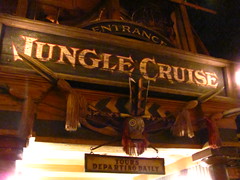 our skipper navigates our miniature steamer through a Best-Of remix of the world’s most exotic locales, apparently leaping across entire oceans without our noticing as one scene near Cambodia’s Angkor Wat is followed up by another within the piranha-infested Amazon river basin. In place of living animals are a multitude of animatronic replicas, augmenting a real safari by ensuring the star inhabitants are always ready to snap their jaws at the exact right moment, rather than sleeping or hiding behind a rock as one would disappointingly find on an actual jungle cruise.
our skipper navigates our miniature steamer through a Best-Of remix of the world’s most exotic locales, apparently leaping across entire oceans without our noticing as one scene near Cambodia’s Angkor Wat is followed up by another within the piranha-infested Amazon river basin. In place of living animals are a multitude of animatronic replicas, augmenting a real safari by ensuring the star inhabitants are always ready to snap their jaws at the exact right moment, rather than sleeping or hiding behind a rock as one would disappointingly find on an actual jungle cruise.
Rather than any individual species or landmark, perhaps the cruise’s most famous attribute is the jokey spiel the skippers recite as they lead us through the attraction’s paces,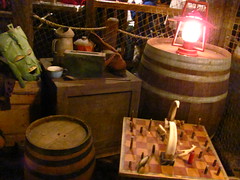 which makes the captive audience ask of themselves if there exists such a thing as a good pun. The Jungle Cruise as first envisioned by Walt Disney featured a scripted spiel that tried to make the attraction believably realistic, not unlike a nature documentary voiceover. The humor merged into the experience over time to the point that Today’s Jungle Cruise is almost a ride-through parody of Yesterday’s Jungle Cruise, an evolution that undoubtedly has many Disney loyalists not laughing. I can understand their point. Unless you’ve got a professional comedian guiding your journey, this narration does tend to distract from the ride rather than complement it, as if the interior and exterior of the steamer exist on slightly unsynchronized planes of reality. The humor does little to humor those who wish to pretend their expedition is real, as one would surely
which makes the captive audience ask of themselves if there exists such a thing as a good pun. The Jungle Cruise as first envisioned by Walt Disney featured a scripted spiel that tried to make the attraction believably realistic, not unlike a nature documentary voiceover. The humor merged into the experience over time to the point that Today’s Jungle Cruise is almost a ride-through parody of Yesterday’s Jungle Cruise, an evolution that undoubtedly has many Disney loyalists not laughing. I can understand their point. Unless you’ve got a professional comedian guiding your journey, this narration does tend to distract from the ride rather than complement it, as if the interior and exterior of the steamer exist on slightly unsynchronized planes of reality. The humor does little to humor those who wish to pretend their expedition is real, as one would surely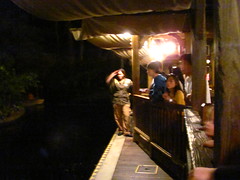 not find attacking headhunters even remotely amusing if believed to be authentic.
not find attacking headhunters even remotely amusing if believed to be authentic.
That said, the evolution toward comedy was an inevitable, perhaps necessary one. The very presence of obviously robotic animals and non sequitur geography imbues the attraction with a nervous humor born of the cognitive dissonance between supposing the absolute fake is actually the authentic reality. This situation would only be worsened if we were in the presence of a human being who seems to effuse a desire to convince us this obvious falsehood is otherwise, and so it became a necessary device to encourage guests to laugh in order to release the built-up tension caused by the contradiction of the unreality. Those that complain the humor limits the emotional depth of the experience must not realize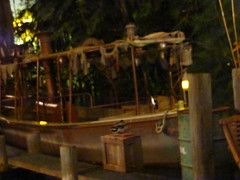 that the experience is fundamentally limited to begin with.
that the experience is fundamentally limited to begin with.
Well, maybe we should interpret the themed environment symbolically. After all, nobody literally believes the Jungle Cruise is in any way authentic. That shouldn’t matter because all representative art is also unreal, but the fact that it is a symbol for some other ideal is always genuine. Animatronic hippos and lions are meaningful interpretations of some humanistic ideal, and they contribute to a holistic narrative that’s directed on a four-dimensional living stage. It might not be Shakespeare, but it is a form of storytelling that tells us something about ourselves and the world by the end of the six minute ride time.
This seems like a promising defense for an argument that a more emotionally serious Jungle Cruise would be superior to the current pun-laden one. The problem is, who on earth thinks of this attraction in terms of symbolism? Symbols don’t aggressively attempt to steal the identity of the thing they symbolize. Theme parks occupy real space in real time, and there is no media filter or fourth wall that identifies the Jungle Cruise as an intentionally artistic representation. The robotic hippos aren’t just a storytelling device. They must be detailed in a way that perfectly supplants a real hippo as best as they can. There is no act of creative interpretation involved. This isn’t to say that free interpretation of the Jungle Cruise is impossible; it’s just unlikely that many people would understand it other than as literally given. Anyone that goes to Disneyland and thinks about the Jungle Cruise in terms of symbolism either holds a liberal arts degree or is French.
It would seem that if we wanted compelling narrative in a theme park attraction, we’d do much better with the additional forty years of technological and artistic development that could be found in the design of the impressive Indiana Jones Adventure: Temple of the Forbidden Eye. My hopes were high. Before even entering the queue, I speculated assertively that this would probably be one of the three best rides we’d find in the entire Disneyland Resort. This was the last major new addition to the Disneyland Park, opening in 1995 a few years before the continually ongoing California Adventure project was announced, and as such it is the most technologically advanced attraction in the original park… to say nothing of the attraction’s gargantuan size or scope. Beyond praise from technology fetishists, this attraction is often heralded for being one of the most successful examples of Disney’s mastery of nuanced storytelling technique in an attraction design. Till now I had always been rather disappointed by the results of these claims, so I was looking forward to some pretty fantastic narratology on this one. I couldn’t wait.
of technological and artistic development that could be found in the design of the impressive Indiana Jones Adventure: Temple of the Forbidden Eye. My hopes were high. Before even entering the queue, I speculated assertively that this would probably be one of the three best rides we’d find in the entire Disneyland Resort. This was the last major new addition to the Disneyland Park, opening in 1995 a few years before the continually ongoing California Adventure project was announced, and as such it is the most technologically advanced attraction in the original park… to say nothing of the attraction’s gargantuan size or scope. Beyond praise from technology fetishists, this attraction is often heralded for being one of the most successful examples of Disney’s mastery of nuanced storytelling technique in an attraction design. Till now I had always been rather disappointed by the results of these claims, so I was looking forward to some pretty fantastic narratology on this one. I couldn’t wait.
 The adventure begins well before we even enter the temple, requiring a lengthy journey through a dense Bengalese rainforest filled with ruins and excavation equipment. Eventually we reach our destination, the namesake Temple of the Forbidden Eye, which begins a winding pathway through dimly lit chambers and corridors filled to the brim with hieroglyphs and defused booby traps. More so than any other ride in the Disneyland Resort, the Indiana Jones Adventure makes the establishment of mood and backstory before boarding the ride a top priority, to the degree that the attraction could lose a significant amount of value if one were to breeze right through the chambers in the FastPass or single rider queues.
The adventure begins well before we even enter the temple, requiring a lengthy journey through a dense Bengalese rainforest filled with ruins and excavation equipment. Eventually we reach our destination, the namesake Temple of the Forbidden Eye, which begins a winding pathway through dimly lit chambers and corridors filled to the brim with hieroglyphs and defused booby traps. More so than any other ride in the Disneyland Resort, the Indiana Jones Adventure makes the establishment of mood and backstory before boarding the ride a top priority, to the degree that the attraction could lose a significant amount of value if one were to breeze right through the chambers in the FastPass or single rider queues.
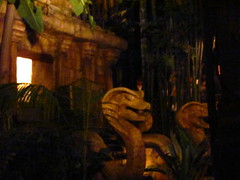 In one of the final rooms we’re presented with a short film which spells out everything that remained ambiguous up to that point. Through old newreel footage and instructional spiels from our tour guide Sallah, we learn that Dr. Jones’ discovery of the temple has become an international sensation, but more recently Jones himself has gone missing. Sallah is now conducting jeep tours through the temple to raise funds, which cleverly explains why the forbidden temple has been flooded with obnoxious tourists. Even cleverer is the subtle use of foreshadowing, as Sallah gently warns us that should we discover the idol on our tour, we must avoid looking into its eye. Oh, and also gazing into the idol’s forbidden eye is strictly forbidden. And one last thing: Beware the eye of the idol!
In one of the final rooms we’re presented with a short film which spells out everything that remained ambiguous up to that point. Through old newreel footage and instructional spiels from our tour guide Sallah, we learn that Dr. Jones’ discovery of the temple has become an international sensation, but more recently Jones himself has gone missing. Sallah is now conducting jeep tours through the temple to raise funds, which cleverly explains why the forbidden temple has been flooded with obnoxious tourists. Even cleverer is the subtle use of foreshadowing, as Sallah gently warns us that should we discover the idol on our tour, we must avoid looking into its eye. Oh, and also gazing into the idol’s forbidden eye is strictly forbidden. And one last thing: Beware the eye of the idol!
 We are reminded of this about once every thirty seconds. Gee, you don’t suppose that’s going to be important later, do ya?
We are reminded of this about once every thirty seconds. Gee, you don’t suppose that’s going to be important later, do ya?
Certainly the stakes are high as we climb aboard our Enhanced Motion Vehicle (EMV), fastening our seatbelts and waiting for the all-clear to enter the temple doors. We’re about to embark on a high-speed, turbulent tour in search for a lost idol, and should anyone on board cross glances with the eye for even a split second, we’ll be engulfed in a raging hellfire and doomed to eternal damnation. I can’t even imagine the insurance policy Sallah must have taken out for this tour company.
Our vehicle kicks into gear, with yours truly behind the wheel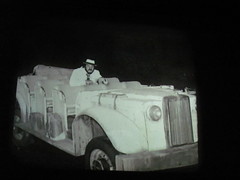 in the driver’s seat (yep, we’re doomed), and we thunder around a right-hand bend into the Chamber of Destiny, which is – never mind, too late to explain it, we’re already barreling through the doors and – damn, this temple evidentially does not want to waste our time! Twenty seconds into the tour we’ve already located the idol without even trying. Of course having been berated by the preshow ad nauseum I was dutiful in averting my eyes, but you know there’s always going to be some joker in your car who has to sneak a peek and ruin it for everybody. The idol growls its disapproval as we round another corner and… well, there’s the final remaining mystery from the preride backstory conveniently solved for us in the first thirty seconds: the whereabouts of Dr. Jones.
in the driver’s seat (yep, we’re doomed), and we thunder around a right-hand bend into the Chamber of Destiny, which is – never mind, too late to explain it, we’re already barreling through the doors and – damn, this temple evidentially does not want to waste our time! Twenty seconds into the tour we’ve already located the idol without even trying. Of course having been berated by the preshow ad nauseum I was dutiful in averting my eyes, but you know there’s always going to be some joker in your car who has to sneak a peek and ruin it for everybody. The idol growls its disapproval as we round another corner and… well, there’s the final remaining mystery from the preride backstory conveniently solved for us in the first thirty seconds: the whereabouts of Dr. Jones.
“You had to look, didn’t you?” he yells as he tries to prop shut a door from evil forces on the other side.
“Hey, don’t be sarcastic with me!” I shout back. “Blame one of these other worthless fuckwads on my tour!”
One thing that became abundantly clear very early in the attraction was that the sense of dramatic timing was atrocious. The sudden transition from quiet, contemplative exposition that’s maintained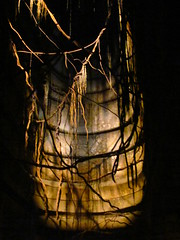 all the way up to the station, to white knuckle hell on wheels with John William’s iconic soundtrack cranked all the way to eleven, is an extremely jarring emotional shift that left me more confused than surprised. If there were supposed to be any plot developments or rising action before the big climatic turning point of the idol discovery, I couldn’t notice them, and I’d like to think I’m looking a lot harder than 99% of people that go through this ride. This haste to cut directly to the main action sequence is perhaps necessary for vehicle blocking reasons, but I was left feeling deflated rather than elated. With the two big plot mysteries resolved in the first thirty second (discovering the Forbidden Eye and finding Indiana Jones) I was already turning apathetic toward the rest of the story. The motivating action from the exposition hadn’t been defined beyond those two developments, and uncertain where the plot was supposed to go next I was released from the narrative hook before the action even had a chance to cook. Of course now it’s clear we have to escape from the temple, but my intuitive reaction in this case was literally, “that’s not going to be hard, just put this sucker in reverse and we’ll be back out the entrance in twenty yards.”
all the way up to the station, to white knuckle hell on wheels with John William’s iconic soundtrack cranked all the way to eleven, is an extremely jarring emotional shift that left me more confused than surprised. If there were supposed to be any plot developments or rising action before the big climatic turning point of the idol discovery, I couldn’t notice them, and I’d like to think I’m looking a lot harder than 99% of people that go through this ride. This haste to cut directly to the main action sequence is perhaps necessary for vehicle blocking reasons, but I was left feeling deflated rather than elated. With the two big plot mysteries resolved in the first thirty second (discovering the Forbidden Eye and finding Indiana Jones) I was already turning apathetic toward the rest of the story. The motivating action from the exposition hadn’t been defined beyond those two developments, and uncertain where the plot was supposed to go next I was released from the narrative hook before the action even had a chance to cook. Of course now it’s clear we have to escape from the temple, but my intuitive reaction in this case was literally, “that’s not going to be hard, just put this sucker in reverse and we’ll be back out the entrance in twenty yards.”
 Even though I’m driving that’s not an option I’m given, and instead we must randomly crash into one scene after another before the ride arbitrarily decides it’s over. What accounts for the remaining 90% of the Indiana Jones Adventure isn’t fundamentally different from any other dark ride shtick: there is a series of unrelated props and gags. The causal relationship between these is not clear, and what exactly we’re trying to accomplish with the plot at this point is even vaguer. It’s just an opportunity to have a series of “neat” technical effects, and to make people jump and squeal several times. All the while our car is bumping and rocking around over “uneven” terrain, an effect that’s supposed to signify this attraction as a top class thrill ride. These Enhanced Motion Vehicles are probably very expensive pieces of technology
Even though I’m driving that’s not an option I’m given, and instead we must randomly crash into one scene after another before the ride arbitrarily decides it’s over. What accounts for the remaining 90% of the Indiana Jones Adventure isn’t fundamentally different from any other dark ride shtick: there is a series of unrelated props and gags. The causal relationship between these is not clear, and what exactly we’re trying to accomplish with the plot at this point is even vaguer. It’s just an opportunity to have a series of “neat” technical effects, and to make people jump and squeal several times. All the while our car is bumping and rocking around over “uneven” terrain, an effect that’s supposed to signify this attraction as a top class thrill ride. These Enhanced Motion Vehicles are probably very expensive pieces of technology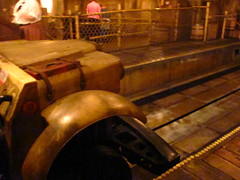 that took years to develop and would require a million nerd photos if ever given a backstage tour, but during the actual ride they enhanced little besides a sense of motion sickness. The problem was probably caused by my vantage point in the front row, where I could clearly see at all times that the road ahead of me was completely flat and paved with a little guide slot down the middle, which resulted in conflicting sensory data between my eyes and my inner ear.
that took years to develop and would require a million nerd photos if ever given a backstage tour, but during the actual ride they enhanced little besides a sense of motion sickness. The problem was probably caused by my vantage point in the front row, where I could clearly see at all times that the road ahead of me was completely flat and paved with a little guide slot down the middle, which resulted in conflicting sensory data between my eyes and my inner ear.
The story gives you all the basic flavors of everyone’s favorite death traps so that no one feels left out. There’s a mummy chamber, a bug chamber, a skeleton chamber, a rat chamber, and a snake chamber, which I suspect exists only so the sound clip of Indy’s famous quip about snakes could be used. The snake is a gigantic, ten-foot tall, 50-foot long cobra. That’s not scary. I don’t know why people think that taking creepy things and magnifying them ten times larger makes them ten times creepier. The psychology of a phobia of large animals is completely different from a phobia of small animals, and I think (evolutionarily speaking) smaller is more effective. Besides, the fact that it was painted a glow-in-the-dark purple and green pretty glaringly destroyed any lingering suspension of disbelief by that point.
More interesting is the central temple chamber, which has tall vaulted ceilings and deep crevices, which we cross through multiple times throughout the journey. The most effective trick is an excursion on a rope bridge dangling over a fire pit when the Enhanced Motion Sickness Vehicle’s engine stalls out, and a large stone god at the far end shoots lasers out of his eyes in an attempt to destroy the bridge; though for an omnipotent deity on his home turf he’s not a very good shot. The positive aspect of this central design feature is that it puts the adventure on a grander scale, expanding the field of vision far beyond what we’re accustomed to for an indoor theme park dark ride. The down side is that it makes it easier to trace the route of the dark ride path into and back out of the various gag chambers, and we can even see other EMSVs at different points on their journey, reminding us that our adventure is in no way unique.
After a couple minutes of non-stop Enhanced Motion Sickness rampage we finally slow down as we approach a long corridor. Our vehicle hesitates for an extended second, and the music even cuts out. For me this moment of silence actually became the most memorable trick in the entire ride, because it was the only time when there was ever a variation in pacing, psychologically suggesting that something was about to happen, rather than something always happening. The gag at the payoff was not particularly worth it; it was a blowdart chamber that triggered a hundred puffs of air, ineffective because the sound effects suggested projectiles that were large and slow enough that they could be partially witnessed with the naked eye, and that we should all be dead by the time we reach the end, requiring our imaginations to fill in the rest of the incomplete effect. Oh well, it was still one of the better tricks on offer.
Now how on earth are they possibly going to top a showstopper that literally involves stopping the car for two seconds and a bunch of compressed air tanks? Tricky, I know, but those clever designers can always think of something, and at this point I realize we’re probably getting close to the point when we’re running out of budget and need wrap up the freeflowing regurgitation of noise and action and tack an unrelated conclusion on the end that will convince people Disney Imagineers are still master storytellers. Rounding the next corner, we come face to face with our hero dangling from a rope, and he informs us he has a bad feeling about this.
He is right. It seems the Forbidden Eye has doomed us to eternal recurrence, that pataphysical condition where we are cursed to relive our lives an infinite number of times with no remembrance of our previous, identical fates. A giant boulder rushes towards Indy and our EMSV, with apparently no one realizing this is exactly the same event as what previously happened in Raiders of the Lost Ark. A chilling climax indeed.
With seemingly nowhere to go, our EMSV drops down a previously hidden descent at the last second before geological annihilation. This was the one trick that still has me gasping “how did they do that,” as it somehow involved reversing the vehicle and releasing an opening in the track. At the bottom of this drop and around the last curve we encounter one last fake Harrison Ford wiping his brow next to a crumbled boulder, which doesn’t quite make sense because the spatial relations between scenes don’t completely add up. The transition between rooms is supposed to play the same function as a cinematic cut between scenes, and this intention is generally understood by riders, but because we’re occupying real four-dimensional space it doesn’t quite gel as naturally as on film. There is a strong intuition that this Dr. Jones is not the same as that previous Dr. Jones because, well, they’re not.
I also am left wondering how the heck Indy escaped from the boulder. This crucial plot point that distinguishes a happy ending from a tragic ending is left totally unexplained. Potentially another failure at adequately linking causation between dark ride scenes, it seems that after a hundred million dollars in research and development, the best resolution to the story is an appeal to an ironically uncommented upon deus ex machina device. Indiana Jones is unshaken by his improbable near-death escape and cracking casual jokes with the tourists as we’re returned to the station.
At the end of the adventure, I cannot say that I am any closer to discovering the elusive meaningful storytelling I’ve been promised and searching for in theme park rides. I disembarked genuinely confused, unconvinced that I could be feeling so much indifference towards an attraction that had so much money and talent behind it.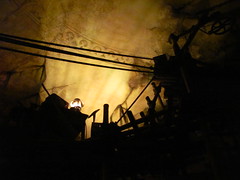
The best explanation I have for this is that the human element is completely lost amid the impossibly huge budget. At the most fundamental level, all forms of fiction and art are about the connection of one human being to another, either through the interpersonal sharing of stories or sounds or visual ideas. They took what was originally a successful cinematic idea and tried to translate it verbatim into the themed environment, not realizing what they were losing in the conversion process and doing nothing to bring it back to life in the unique dark ride medium.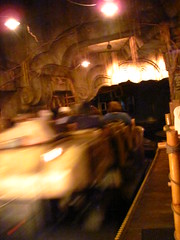
On the screen you see live human actors, spontaneously reacting to the world they find themselves in. The director, cinematographer, and editor, meanwhile, are always hiding just behind us, reinforcing a continuous sense of identity as they lead us through this world along with their characters. Our perspective is their perspective, and unless we’re watching surveillance footage, in the movies we take comfort in the fact that no matter whom we’re with or what we see on screen, we are never really alone.
It’s not the same on the Indiana Jones Adventure. Here we find ourselves completely alone and isolated, our perspective shared with exactly no one but ourselves. All the other humans are either lifeless preprogrammed duplicates, droning cast members with no free will beyond serving us efficiently and with a smile, or are just as alone and confused in this vast mechanical world as we are. We share in the thrills and the laughs with others in our EMSV, but more in the way we comment on some natural event like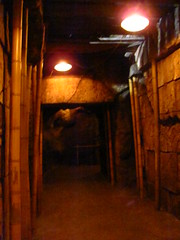 a white water rapids adventure. The attraction’s creators remain anonymously hidden behind the walls, directing the action at us but not with us. Any individual act of creative expression is muted against the vastness of the project and the requirements of the franchise.
a white water rapids adventure. The attraction’s creators remain anonymously hidden behind the walls, directing the action at us but not with us. Any individual act of creative expression is muted against the vastness of the project and the requirements of the franchise.
This natural deficiency found in recreating a cinematic environment in a real four-dimensional space could perhaps be forgiven if the story was ever compelled by anything deeper than random action and effects, but I’d be hard-pressed to mount such a defense for the Indiana Jones Adventure.
It is a tale told by an idiot, full of sound and fury, signifying nothing.
To expand this subject even further: the argument at the end of this review about how the Indiana Jones Adventure’s lack of human involvement undercuts its ability to be a genuine form of “storytelling”, I had originally developed as a theoretical counter-argument to the claim that unthemed roller coasters could be considered art.
It seems to me that a necessary condition for something to be called an artwork (which obviously includes storytelling) is not just that some idea or aesthetic experience is communicated, but that we realize another sentient being is directly or indirectly expressing that idea to us.
This is obviously true in most traditional art forms, such as poetry and theater, and even music (there is almost always a performer or composer, and music is intrinsically linked to language) and visual arts (again, we always view a painting or sculpture with the background knowledge that it was created by an individual wishing to convey some representation to us).
In a roller coaster that sense of communication gets lost. Even if it’s clear that the ride is built by humans, the specific experience it provides is rarely intuitively understood as a set of aesthetic choices from the designer, with the hope directly communicating that idea or feeling to us.
I think the way to save roller coasters (and even Indiana Jones Adventure) from this argument might be to use an analogy of architecture, which are similarly large scale and has a lot of technical engineering priorities. If the structure is purely functional, then it fails the “human communication” test for artwork, because it is built in response to natural conditions and mechanical laws. If it has properties designed exclusively to appeal to the faculties of aesthetic judgment, then we can say it communicated something from the architect to the viewer. Hence why some structures such as Fallingwater or the Chrysler Building are routinely categorized as works of art, while many other structures (the majority of suburban homes, gas stations, etc.) are not. It’s a bit fuzzy where the boundaries are since it’s obvious most structures have some stylistic choices which are not purely functional in nature, but we’ll worry about that later since for the purposes of the immediate topic I’m not interested in all architecture.
I’m still not certain if this will completely defend the Indiana Jones Adventure, since it could be argued that the attraction is still wholly functional in design. The set pieces and special effects have a function to imitate a real forbidden temple, and they are judged based on their success at meeting the technical goals. Judgments of aesthetics and storytelling seem to be a bit distant and removed from the immediate experience, especially to the degree that a human is/was responsible for communicating the story of the temple to us. I can instantly think of a lot of strong counterarguments against this theory, so I would not defend anything I put forth here without further time for reflection.
Whether or not Indiana Jones Adventure constitutes a genuinely artistic mode of storytelling I’m not certain; but if it does count, I will be quite positive that the story is not a very good one.
I’m surprised you didn’t figure out the boulder effect! Glad it was effective.
Here’s an animation how it works:
http://www.youtube.com/watch?v=2acEo04xfog
It’s too bad that Indy is a shadow of its former self. Over the years, it has slowly lost many of its effects that make it unique. Today I’d say that Haunted Mansion, Pirates of the Caribbean are far better attractions–and many others are arguably better.
I’m interested–how would you compare the Tokyo version to the California version? While the storyline, or lack of, is nearly the same, the Tokyo version’s theming is much more elaborate.
Ah, thanks for the diagram. I actually thought that the track itself somehow collapsed downward when the vehicle “backed up” to allow it to fall down. I don’t recall there being a dip in the track when we first pull up, I guess it must have been a combination of strategic lighting and the tall vantage point of the vehicle. Yeah, that was an effective effect.
As for the Tokyo version, it’s interesting: I would say that I found that version more effective, but for me it really had nothing to do with more elaborate props and themeing. Actually I don’t even recall there being much of a difference in the ride experience besides a change in setting, they both seemed to be on roughly the same level of technical quality.
Where I would make a key distinction between the two is that the approach of the Tokyo ride seemed to be much more of a BYOB affair (Bring Your Own Backstory). You just walk into a big Mayan temple, everything is unexplained, and the safety spiel video with Paco is pretty much just a simple safety spiel (no News of the World or constant foreshadowing or anything).
As a result I’m not trying to mentally establish a continuity of events from the queue and preshows onto the ride itself, which was a factor in one of my disappointments with the California version. The storyline basically begins with the start of the ride in the middle of an action scene, which is almost identical to the rapid opening scenes on the California version, only you don’t need to suppose that the entire experience from as soon as you enter the queue is somehow literally real.
Paradoxical as it may seem, I found this strategy that made the Tokyo attraction seem more like an ordinary amusement ride than a real-life adventure to also be more effective, because the narrative is better framed as a short story that lets you cut right into the action and then be taken out of it once you’ve found resolution. It feels more symbolic and like there’s someone that’s actually trying to represent a story to me through this dark ride medium, rather than presenting it as a huge spectacle where the human element becomes muddled by the requirements of hypperality I’ve been harping on about for the past few weeks.
I’m sure I’ll have more to say about it when I get to the Tokyo DisneySea reviews, although since that will obviously not be for a while I wanted to give an analysis of the ride here since the comparison is obviously of particular relevance right now.
In Indiana Jones Adventure’s defense, the story is supposed to be that this “Chamber of Destiny” has been found already (no need to locate the idol) and that any visitors who enter are granted one of three gifts – eternal youth, earthly riches, or visions of the future. You’re SUPPOSED to encounter Mara straightaway. It’s just that, when you do, you can’t look into his eye. Otherwise, great as awlays!
I thought I remember from the pre-ride videos that Dr. Jones and maybe a few others had located the idol and reported back with the news but then disappeared, so they were conducting tours of the temple only on the condition that we *might* discover idol if we’re (un)lucky. The hypothesis that Sallah is conducting a routine museum tour of an artifact in the next room that, if you look at it, you get sent straight to hell (which I guess makes Indy in the following scene the crusty old museum curator who yells at you for touching the glass) I’m slightly incredulous of, but I guess it makes a bit more sense given that is basically how they start the attraction.
Regardless of how the story was supposed to work, I think it would have been infinitely improved if they could have spent more time building tension and had a wider variety of pacing and mood. Instead they crank the dial all the way up to 11 within the first thirty seconds, and there it’s stuck for almost the entire ride.
I totally understand that. I also don’t mean to overlook the point you were actually trying to make about the ride being too “transportational” and taking itself far too seriously instead of embracing its status as an amusement park attraction. I think you’re spot on there, but I also might argue that the “one-two punch” of effect after effect after effect does precisely that: reminding you that you’re on an attraction. Consider The Amazing Adventures of Spiderman (where each villain, in succession, gets one and exactly one 3-D screen to terrorize you with their trademark attack) or really, any traditional haunted house (where you might encounter a “spider room,” a “skeleton room,” a “graveyard,” a “torture chamber,” etc) whose purpose is to transport you, but also to give you quick samplings of the overall experience in a very attraction-oriented way.
In another sense, you might do what Disney almost certainly does and call the Indiana Jones Adventure an “experience” or “attraction,” not a “ride.” In that case, one might argue that from a story-centered perspective, the winding queue, remnants of expeditions, pre-show area, etc. function as the quiet, tension-building entrance into the temple that Indiana Jones experienced himself in all of the films. It’s the rising action to the climax of looking into the idol’s eyes. It just so happens that the “ride” half of the attraction kicks in fairly close to that climax and well into the rising action, but all the plot elements are arguably still there and still proportionally represented.
There is much evidence of the “idol has already been found” storyline I commented on above (for example, a mural when first entering the queue house displays Mara – eyes closed – holding a vase of water with a purple All-Seeing Eye medallion around his neck and gold coins around him) that represents the “three destinies” of the ride. The “Eyes on the Globe” program in the pre-show establishes the 1930’s setting comedically, mentioning that the “creme de la creme of the international smart-set are wearing khaki this year, and the new vacation hot spot is the Temple of the Forbidden Eye. Everyone’s agog over this ancient find by famed archaeologist Indiana Jones. There are rumors that it rewards visitors with gold, eternal youth, or visions of the future.” I guess my argument here is that the backstory is established for those who truly wish to understand it (people like ourselves). In all fairness, most guests probably don’t care about about the story anyway, but it continues to be there for people like us.
The thing I’m surprised you didn’t mention is the illusion of the ride’s three initial pathways. Upon entering, a sliding facade makes it appear that you’re entering one of three rooms (one dedicated to each of the three destinies promised by the idol). The left-most door is the Observatory of the Future; the middle door is the Chamber of Riches; and the far right is the Fountain of Youth. Obviously it’s the same physical pathway, but as the wall façade slides, scrims are lit differently, lights turn on and off, music changes, and vehicle motion is determined by the computer’s choice of pathway. In the future room, for example, lights at the bottom of the room are a dim purple, scrims are unlit, and an LED star-field is projected on the sky while the vehicle tips back to view it.
Even loosely, it’s supposed to look as though visitors are about to receive the gift of future sight. In the Fountain of Youth “room,” watery-reflection is projected on the walls. The scrims lit from the front show ancient people drinking water and becoming younger, while statues of women pouring out vases of water are lit (statues that are unlit and truly unnoticeable when the room is cast in reflections of gold coins, with sound and motion insinuating that you’re driving over heaping piles of money and scrims lit from behind show treasuries brimming with gold and silver). Before you even enter the room, you see the three doorways with lightly glowing eyes above. As you approach one of the three, those eyes illuminate more intensely and Mara speaks, saying “You have chosen wisely! This path leads to timeless youth and beauty!” or “You seek the treasure of Mara. Glittering gold! It is yours…” or “You seek the future. I will lift the curtain of time. It is your destiny.”
Keep in mind that many of the effects that furthered the whole Forbidden Eye concept have gone without rehab (with Mice Chat reporting that the ride will have a full two-month closure this fall – the first major rehab since 1995). For example, at the end of the hallway with the first encounter with Mara’s face, a cloud of fog originally covered it. Then, one strobe would flash in Mara’s eye, almost immediately drawing the car’s attraction. Right away, the “pupils” in the eye would begin spraying air (something they still do, despite the fog being gone) that dispelled the cloud and made it clear that the flashing you had just turned to look at was Mara’s eye. That’s when he would shout “No! You looked into my eyes…” etc. The fog doesn’t work anymore, but you can see the eyes blowing half-smokey air in many POV videos.
I’m sorry to have gone off on a tangent here. I’m the last person you’d consider a “Disney fanboy.” I’ve only been to the resort twice in my life, but I have a particular affinity for this attraction. I’m not even “defending” it per se, just offering a few alternate things I’ve noticed and possibly showing you something you may not have known! I’ll include videos of the three pathways if you’re interested in checking that out. Many, many, many people swear that the rooms represent different “intensities,” purporting that a Disney cast member might see small children in the jeep and send the room on the “water” course, which they claim has a milder set of motions. I’ll link to three POV videos with the three destinies below. Recognize that many of the effects (differently lit scrims, hidden statues, etc.) are negated by night vision, limiting the choices of videos.
Future Chamber: http://www.youtube.com/watch?v=XtcY68suGsQ
Water Chamber: http://www.youtube.com/watch?v=wP37F8CKwS8
Riches Chamber: http://www.youtube.com/watch?v=_-rTvcUET-Y
Oh, and one last thing. One of the best “storytelling” devices I enjoy is the ride is when you first turn the corner after seeing Indiana Jones and you finally see the enormous temple complex that the ride takes place in (first seeing the suspension bridge, etc). The statue across the way (which you didn’t allude to in your post, so I’m not sure if you noticed) is Mara once again, but with half of his face crumbled, including his one “forbidden eye” shooting flames and his mouth acting as a lava waterfall. Upon first seeing it, the music swells (see above videos) and it’s just a really dramatic moment for me. Almost emotionally impacting.
Everything you said about the ride’s faults remains true. Just offering up a few other details! Love the site and the insight you provide. Thanks!
I do see what you mean… thank you so much for taking the time to explain it this well. The thing about the pre-ride is that I think if they wanted to launch right into the ‘climax’ at the start of the attraction, they needed to do a lot more to engage people in the queue before getting into the EMVs. As you noted, it’s entirely possible for someone who doesn’t care to completely ignore the backstory told throughout the queue. Even for those of us who do pay attention, it’s really much too passive an experience up to that point for us to engage emotionally with the story. It’s basically all exposition and maybe a little bit of dark atmosphere, but the last video before the pre-ride is almost all comic relief. Then once we’re on the ride, it very suddenly jumps to dark and aggressive, and in my opinion as someone who was trying to pay attention to the story in the queue and had high expectations on my very first ride, I found this initial tonal shift way too jarring, and I don’t know if I ever caught up with the ride after that, so to say. Although I wouldn’t describe myself as a huge fan of Tower of Terror, the use of the queues and preshows to reveal exposition while simultaneously ratchet up tension before the ride begins is far more successful, especially in the Tokyo version. In fact, I’d say that ride almost has the opposite problem, as I usually find the lead-up is more satisfying than the pay-off it was leading up to.
I think you’re right that if I had gone into the Temple of the Forbidden Eye with the mentality that this was just a really expensive, high-tech evolution of the classic Laff-in-the-Dark rides, I would have had a much more favorable opinion, since it does seem to be channeling a lot of those same energies in terms of beats (especially in ultra-tacky cobra chamber). But you seem to agree with me, that’s not the expectations we have. They seem to really want to make us believe this story is real and continuous with the outside world (even going to somewhat good lengths to explain why the temple is infested with tourists), which again is why I think the transition from the queue to the ride was handled very poorly and is the biggest demerit of the attraction. Of course I would have preferred if the ride could have lived up to the cinematic, multifaceted story that seemed promised in the queue, rather than remove exposition from the queue so we’re only expecting a gag-based sequence of events. The Tokyo Crystal Skull version goes for the latter solution rather than the former (although much larger and more elaborate than in California, the Tokyo queue strips out most of the exposition so we seem to just cut right into the middle of an Indiana Jones action sequence) and in my opinion that was ironically the main reason it was the more successful attraction.
I’m not sure how much having the effects fully restored would improve my opinion of it, although they certainly wouldn’t hurt. However, it sounds like from your description the fog curtain would have been very important for the story, since as I recall you turn the corner and then directly in front of you at the end of the hallway you already can see Mara, and then as you move through the room you notice the chamber you’re supposed to notice before you get the idol, and the narration and response to us looking into the eyes seems like it’s delayed. Hopefully that’s the top priority to be fixed, I’ll have to see if the first scenes ‘feel better’ to me next time I’m in LA.
I’ll be honest, the reason I skipped over the first chamber of destiny or whatever was because I hardly even noticed it or knew what it was… I don’t think this was really explained in the queue, was it? Anyway, it seems to last for less than ten seconds, and once the shit hit the fan in the immediate next scene my brain must have filed it away as not important. I actually had to read about it in Wikipedia while I was writing this review to remember that first scene even existed! Maybe that’s just my fault and everyone else understood and remembered it with no problem, but still…
By the way, I agree that the moment when you enter the main chamber and see the idol’s face from across the pit is probably the best part of the entire attraction.
Anyway, thanks again for taking the time to clearly explain your perspective. Even for us “non-Disney fanboys”, they’re far too big a force in the industry for anyone to not have a detailed opinion about.
Wow… This was all amazingly descriptive. It’s always interesting for someone who IS a “Disney Fanboy/girl” to hear such detailed analysis from people who aren’t.
I am much more of a Disney World fan, but it’s great to see someone who can see the positives and the flaws in a Disney attraction. Sadly, I still have yet to ride the Indiana Jones Adventure, but I feel like the acclaimed storytelling in many Disney attractions isn’t as incredible as it is built up to be. No doubt, Disney parks tell stories, and usually tell them quite well, but they are a victim to their own fame.
Thanks foe such a different take on Disney and theme/amusement parks in general. I’ve spent many an hour reading the posts here.
Umberto Eco’s “Travels Through Hyperreality” is a great text to read if you’re looking for detailed analyses of theme park attractions from people who have a completely different perspective on theme parks from the fans; in this case, from the perspective of semiotics and social criticism. I think you can still read the entire Disneyland section for free in the preview on Google Books. I refer to Eco’s work quite a bit throughout my reviews, so if you enjoyed my writing that’s the next place I would tell you to look.
I also recently enjoyed a fun philosophical essay by H. Peter Steeves titled “A Phenomenologist in the Magic Kingdom”, part of a book called Phenomenological Approaches to Popular Culture. You can read significant parts of the essay on Google Books as well, but you’ll need to buy it or find it in a library to get the omitted pages. There’s plenty more like-minded reading out there, although most of it is focused just on Disney parks because they’re such a powerful cultural magnet. In general I find that writings about theme park experiences from ‘outsiders’ tend to be far more insightful and intellectually stimulating than you can get from the fans and people within that tradition.
Thank you very much for the kind words, I’m always glad to hear when my writing is of interest to people!